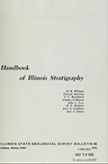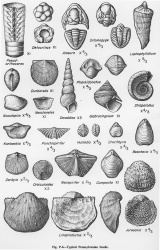Historical:St. David Limestone Member
Lithostratigraphy: Kewanee Group >>Carbondale Formation >>St. David Limestone Member
Chronostratigraphy: Paleozoic Erathem >>Pennsylvanian Subsystem >>Desmoinesian Series
Allostratigraphy: Absaroka Sequence
Authors
M. E. Hopkins and J. A. Simon
Name Origin
The St. David Limestone Member of the Carbondale Formation (Savage, 1927, p. 309) is named for St. David, Fulton County.
Type Section
The type section consists of outcrops near the village of St. David (SE SE 17, 6N-4E) (Wanless, 1956, p. 10; 1957, p. 105, 197).
Extent and Thickness
The St. David is widespread in western Illinois, where its thickness is generally less than 1 foot but locally reaches 2 feet. In eastern and southwestern Illinois also it is persistent and locally is 3-4 feet thick. In southeastern Illinois and western Kentucky, it is continuous but is commonly no more than a few inches of very fossiliferous calcareous shale or impure limestone.
Description
The St. David is a thin, dark gray, argillaceous limestone containing an abundant open-marine fauna dominated by brachiopods; it also contains a few fusulinids. It is almost invariably present where the Springfield-Harrisburg (No. 5) Coal occurs, although the limestone and coal are generally separated by 1-3 feet of black fissile shale. The underlying black fissile shale is widely characterized by an abundance of Dunbarella rectilaterarius (fig. P-6) in its lower few inches. The St. David is usually absent where the gray Dykersburg Shale, which underlies it in places, is more than 25 or 30 feet thick.
References
SAVAGE, T. E., 1927, Significant breaks and overlaps in the Pennsylvanian rocks of Illinois: American Journal of Science, v. 14, p. 307-316.
WANLESS, H. R., 1956, Classification of the Pennsylvanian rocks of Illinois as of 1956: Illinois State Geological Survey Circular 217, 14 p.
WANLESS, H. R., 1957, Geology and mineral resources of the Beardstown, Glasford, Havana, and Vermont Quadrangles: Illinois State Geological Survey Bulletin 82, 233 p.
ISGS Codes
| Stratigraphic Code | Geo Unit Designation |
|---|---|

